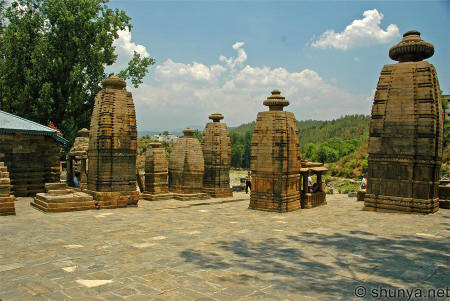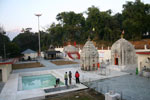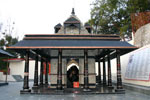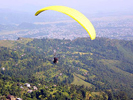-:
Hindu Temples :-
Lord Shiva Temples
Baijnath Temple

Baijnath (32° 3’ North lat. And 76° 41’ East long.), a small township in the Dhauladhar range of western Himalayas, 16 km from Palampur in the Kangra District of Himachal Pradesh is famous for its 13th century temple dedicated to Siva as Vaidyanath, ‘the Lord of physicians’. Originally known as Kiragrama, the town lies on Pathankot-Chakki-Manali highway (National Highway No. 20) almost midway between Kangra and Mandi. The present name Baijnath became popular after the name of the temple. The town is located on the left bank of the river Binwa, a corrupt form of ancient Binduka, a tributary of river Beas.
The Baijnath temple has been continuously under worship ever since its construction in 1204 A.D. by two local merchants named Ahuka and Manyuka. The two long inscriptions in the porch of the temple indicate that a temple of Siva existed on the spot even before the present one was constructed. The present temple is a beautiful example of the early medieval north Indian temple architecture known as Nagara style of temples. The Svayambhu form of Sivalinga is enshrined in the sanctum of the temple that has five projections on each side and is surmounted with a tall curvilinear Shikhara. The entrance to sanctum is through a vestibule that has a large square Mandapa in front with two massive balconies one each in north and south. There is a small porch in front of the mandapa hall that rests on four pillars in the front preceded by an idol of Nandi, the bull, in a small pillared shrine. The whole temple is enclosed by a high wall with entrances in the south and north. The outer walls of the temple have several niches with images of gods and goddesses. Numerous images are also fixed or carved in the walls. The outer doorway in the porch as also the inner doorway leading to the sanctum of the temple are also studded with a large number of images of great beauty and iconographic importance. Some of them are very rare to be found elsewhere.
The temple attracts a large number of tourists and pilgrims from allover India and abroad through out the year. Special prayers are offered in the morning and evening every day besides on special occasions and during festive seasons. Makara Sankranti, Maha Shivaratri, Vaisakha Sankranti, Shravana Mondays, etc. are celebrated with great zeal and splendor. A five day state level function is held here on Maha Shivratri every year.
Besides this temple there are other ancient shrines in and around the place such as Mahakala temple complex that has recently been renovated, the Sidhanath temple, Mukutanath temple etc. Besides the serene surroundings and salubrious climate of middle range hills of Baijnath, tourists interested in adventure can also enjoy paragliding at nearby (about 10 km) Bir and go for trekking in the region.
Structure of Temple
Standing in its pristine glory, facing west, on the northern side of the mountain with the river Binduka flowing about one hundred meters below, the temple, with its curvilinear sikhara joined through a vestibule (antarala) with a square mandapa having beautiful balconies in the north and south and an entrance-portico (mukha-mandapa) preceded by a Nandi-shrine, catches the attention of not only visitors, devotees and critics but even of a casual passer by.
The entire complex surrounded by a wall measures 36.5 mt. in length from east to west, 21.10 mt. in width in the east and 19.55 mt. in the west. The main entrance, through stairs, is on the southern side with two shrines having the images of Ganapati and Hanumana on either side. There is another entrance in the western corner of the northern side. A doorway in the northern corner of the eastern wall, that may have been a later addition, is kept locked at present. Besides the main building of the temple there are some smaller shrines in the courtyard. A very conspicuous figure is that of a standing Nandi, some distance behind the Nandi shrine, that was placed at a later period.
The Nandi-mandapa in front of the entrance porch has a seven tiered pyramidal roof topped by an amalaka and a kalasa supported by four pillars and brackets of the same style as those of the entrance porch. It measures 116 cm. x 120cm. With the pedestal of the Nandi measuring 36 cm. x 100 cm. The image of Nandi enshrined in it appears to be the original one of the 13 th century.
Next to it is the entrance porch (mukha-mandapa) measuring 3.10 x 2.31 mt. having beautiful pillars of classical order in front with a square base on which is cushion like circular mouldings above which are the slender plain circular shafts crowned by ghatapallava motifs and square abaci and ornamental sridhara brackets. The roof supported on lintels above the brackets has receding three tiers with an amalaka and a kalasa on the top.
The mandapa, almost a square, measuring 8.50 x 8.30 mt. has the three usual limbs bhadra, pratibhadra and karna. It is joined to the entrance porch through a doorway and has two massive balconies on the north and south respectively. The plinth and the vedibandha have the same characteristics as those of the garbhagriha viz. the pitha consisting of a bhitta and jadyakumbha and the vedibandha with mouldings – khura, kumbha, purnaratna, kalasa, pattika and kapotali. The jangha has bhadrikas (niches on the bhadras) supporting images (infra). In the four corners are buttresses with niches in the shape of shrines with sikhara rising to almost two third of the mandapa’s height. The roof of the mandapa has six horizontal receding tiers, giving it a pyramidal shape and is topped with an amalaka and a kalasa.
At the entrance of the mandapa are two pillars each with a square base having each side 42 cm. topped by circular shafts and purnaghata with foliage capitals. Four massive pillars support the lantern type ceiling of the mandapa, measuring 5.40 x 5.10 mt with their square bases measuring 53 cm. across.. The round shafts are topped by octagonal bands and purnaghata capitals. The architraves on these pillars divide the ceiling of the mandapa into nine square and oblong sections. The center of the ceiling is reduced to a quarter of the original and beautifully decorated by swirling foliage by way of concentric circles.
The most important part in the mandapa is the two balconies. With their different type of sculptures and mouldings that do not go with those of the rest of the mandapa and the garbhagriha. However, the balconies are not a new addition but only renovated at a later date.
Next to the mandapa is the antarala or vestibule. It has two pillars at the entrance with a square base, 28 cm. above floor, each side measuring 32 cm. The ceiling of the antarala has three round lotus motifs carved on it. The highly ornate doorway to the garbhagriha attracts the visitors.
The garbhagriha forms the most important feature of the temple and is intact in its original form. Pancharatha in plan, it measures 5.00 mt across and rises to the height of 14.20 mt. from the base to the finial. The bhadra niches on its outer walls have circular columns on both sides resting on plinth and topped with capitals and abaci. Besides the niches (rathikas), the walls have various motifs for decoration. The sikhara above the jangha consists of nine storeys each marked by a karnandaka and artistically decorated with intertwined gavaksha arches. On the top are amalaka and kalasa above that is finial with a trident. In the front of the sikhara is a beautiful round medallion in the center depicting three faces of Siva.
Inside the garbhagriha measures 2.30 mt. across. The ceiling of the sanctum is also of lantern pattern with a lotus rosette in the center. It has a svayambhu Sivalinga in the center, which is believed to be an Ardhanarisvara form of Siva, probably the only lingam known as such. At the floor level is made a white marble yonipitha around the Sivalinga with a design of a serpent around it. It leads to the sacred water outlet (pranala ) going out in the northern wall. A beautiful image of snake, made of silver, with raised hood is placed around the Lingam.
Other Attractions nearby Baijnath Temple
 Mahankaal
Temple Mahankaal
TempleThis is another ancient temple dedicated to lord Shiva situated 5 Km away from Baijnath.  The
main temple was constructed sometimes in medieval period. Temples
dedicated to Shani and Hanumaan have been added in February,
2006. The temple is visited by numerous devotees particularly during the
Saturdays of Bhadrapada (August-September). The
main temple was constructed sometimes in medieval period. Temples
dedicated to Shani and Hanumaan have been added in February,
2006. The temple is visited by numerous devotees particularly during the
Saturdays of Bhadrapada (August-September).
Mukutnath Temple Khir Ganga Ghats Trekking Routes
Tatwani (Hot water Springs) Binwa Hydro-electric Project: Mahavatar Baba Ji Meditation Centre
|
How to Reach There
|
Baijnath lies on the Pathankot-Chakki-Manali National Highway No. 20,
half way between Kangra and Mandi. It is about 130 Km from Pathankot, the nearest broad gauge rail head and airport. Kangra airport at Gaggal near Dharamshala from where small aircraft flies on alternate days to Delhi is 60 Km from Baijnath. There is also available a toy train from Pathankot to Paprola-Baijnath which runs on narrow gauge from Pathankot to Jogidernagar. Baijnath is very well connected by all weather roads to Delhi via Chandigarh and to Manali via Mandi. |
|||||||||||||||||||||||||||||||||||||||||||||||||||||||||||||||||||||||||||||||||||||||||||||||||||||||||||||||||||||
|
Distance By Bus (Bus Stand Baijnath 01894-263053)
For HRTC Route time table click here:- |
|||||||||||||||||||||||||||||||||||||||||||||||||||||||||||||||||||||||||||||||||||||||||||||||||||||||||||||||||||||
|
Distance by Train The narrow gauge line from Pathankot passes through Kangra, Maranda(Palampur), Baijnath and reaches Joginder Nagar. The Railway reservation facility is also available at: The schedule for these narrow gauge trains is given below: Train Schedule for Up Trains
For other details click here :- By Air
Contact Temple Management for Further Information :
|
|||||||||||||||||||||||||||||||||||||||||||||||||||||||||||||||||||||||||||||||||||||||||||||||||||||||||||||||||||||

 Paragliding
Paragliding Sherab Ling Monastery
Sherab Ling Monastery